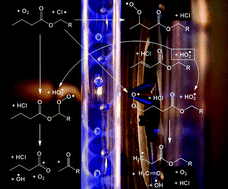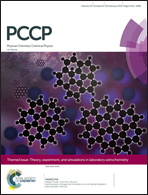Study of low temperature chlorine atom initiated oxidation of methyl and ethyl butyrate using synchrotron photoionization TOF-mass spectrometry†
Abstract
The initial oxidation products of methyl butyrate (MB) and ethyl butyrate (EB) are studied using a time- and energy-resolved photoionization mass spectrometer. Reactions are initiated with Cl˙ radicals in an excess of oxygen at a temperature of 550 K and a pressure of 6 Torr. Ethyl crotonate is the sole isomeric product that is observed from concerted HO2-elimination from initial alkylperoxy radicals formed in the oxidation of EB. Analysis of the potential energy surface of each possible alkylperoxy radical shows that the CH3CH(OO)CH2C(![[double bond, length as m-dash]](https://www.rsc.org/images/entities/char_e001.gif) O)OCH2CH3 (RγO2) and CH3CH2CH(OO)C(
O)OCH2CH3 (RγO2) and CH3CH2CH(OO)C(![[double bond, length as m-dash]](https://www.rsc.org/images/entities/char_e001.gif) O)OCH2CH3 (RβO2) radicals are the isomers that could undergo this concerted HO2-elimination. Two lower-mass products (formaldehyde and acetaldehyde) are observed in both methyl and ethyl butyrate reactions. Secondary reactions of alkylperoxy radicals with HO2 radicals can decompose into the aforementioned products and smaller radicals. These pathways are the likely explanation for the formation of formaldehyde and acetaldehyde.
O)OCH2CH3 (RβO2) radicals are the isomers that could undergo this concerted HO2-elimination. Two lower-mass products (formaldehyde and acetaldehyde) are observed in both methyl and ethyl butyrate reactions. Secondary reactions of alkylperoxy radicals with HO2 radicals can decompose into the aforementioned products and smaller radicals. These pathways are the likely explanation for the formation of formaldehyde and acetaldehyde.



 Please wait while we load your content...
Please wait while we load your content...